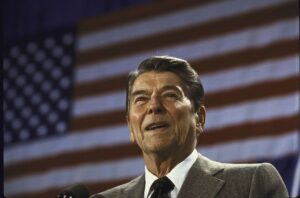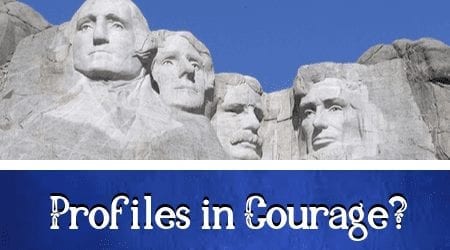-
Founding Presidents (1789-1829)
- George Washington: The Father of the United States – Lesson
- John Adams: A Stubborn but Dedicated Leader – Lesson
- Thomas Jefferson: The Author of Independence – Lesson
- Founding Presidents: Washington, Adams, and Jefferson – Quiz
- James Madison: The Father of the Constitution – Lesson
- James Monroe: Opposing the Federalists – Lesson
- John Quincy Adams: The Federalists who Abandoned the Party – Lesson
- Founding Presidents: Madison, Monroe, and Adams – Quiz
-
Civil War Presidents (1829-1869)
- Andrew Jackson: The First Democrat – Lesson
- Martin Van Buren: The Little Magician – Lesson
- Civil War Presidents: Jackson and Van Buren – Quiz
- William Henry Harrison: The Indian-Fighter – Lesson
- John Tyler: The First President to Not Be Elected – Lesson
- James Polk: Young Hickory – Lesson
- Zachary Taylor: Old Rough and Ready – Lesson
- Millard Fillmore: The Last Whig President – Lesson
- Franklin Pierce: A President Ruined by Slavery – Lesson
- Franklin Pierce: A President Ruined by Slavery – Quiz
- James Buchanan: A President for States’ Rights – Lesson
- James Buchanan: A President for States’ Rights – Quiz
- Abraham Lincoln: The Great Emancipator – Lesson
- Abraham Lincoln: The Great Emancipator – Quiz
- Andrew Johnson: The First President to Be Impeached – Lesson
-
Reconstruction Presidents (1865-1901)
- Ulysses S. Grant: A Friend of Mark Twain – Lesson
- Ulysses S. Grant: A Friend of Mark Twain – Quiz
- Rutherford B. Hayes: The First President to Lose the Popular Vote – Lesson
- Rutherford B. Hayes: The First President to Lose the Popular Vote – Quiz
- James A. Garfield: The Last of the Log Cabin Presidents – Lesson
- James A. Garfield: The Last of the Log Cabin Presidents – Quiz
- Chester A. Arthur: A One Term President – Lesson
- Chester A. Arthur: A One Term President – Quiz
- Grover Cleveland: A President of Principle – Lesson
- Grover Cleveland: A President of Principle – Quiz
- Benjamin Harrison: The Second President in His Family – Lesson
- Benjamin Harrison: The Second President in His Family – Quiz
- William McKinley: The Third Presidential Assassination – Lesson
- William McKinley: The Third Presidential Assassination – Quiz
-
20th Century Presidents
- Richard Nixon: The Only President to Ever Resign – Lesson
- Richard Nixon: The Only President to Ever Resign – Quiz
- Gerald Ford – America’s First Unelected President – Lesson
- Gerald Ford – America’s First Unelected President – Quiz
- Jimmy Carter – the President Who Promised He’d Never Lie – Lesson
- Jimmy Carter – the President Who Promised He’d Never Lie – Quiz
- Ronald Reagan – The ‘Peace Through Strength’ President – Lesson
- Ronald Reagan – The ‘Peace Through Strength’ President – Quiz
Ronald Reagan – The ‘Peace Through Strength’ President – Lesson
The president believed less government is better for the people.
Ronald Reagan (1911 – 2004) was dubbed the “Great Communicator.” As the 40th president of the United States, he was able to stimulate economic growth, increase employment, lower inflation, and strengthen the country’s national defense. His “less government is better” approach appealed to the American people and helped him to win two terms in the White House.
Ronald Reagan – The Early Years

Ronald Reagan (Photo by Dirck Halstead/Getty Images)
Ronald Wilson Reagan was born on February 6, 1911, in Tampico, Illinois. The family lived in an apartment that didn’t even have indoor plumbing or running water. Throughout his school years, Reagan was very active in sports, student council, and theater. It was the latter that would propel both his personal and his political careers.
After first becoming a radio sports announcer, the young Reagan gave a try at a screen test in 1937, which won him a Hollywood contract. For the next 20 years, he acted in 53 films. He became president of the Screen Actors Guild and started arguing with fellow entertainment staff about communism in the film industry. Reagan had always been a Democrat until this point, when he switched from a liberal to a conservative and started touring the country as a television host, speaking on the merits of conservatism.
In 1966 Reagan went into politics and was elected governor of California by a whopping margin of one million votes. He was re-elected in 1970.
Road to the White House
In 1980, Reagan became the Republican nominee and went on campaign for president, promising to restore “the great, confident roar of American progress and growth and optimism.” He chose as his running mate former Texas Congressman and United Nations Ambassador George Bush. He battled for the presidency against President Jimmy Carter and won with 489 electoral votes compared to Carter’s 49.
On January 20, 1981, Reagan was sworn into office. He was 69 years old at the time, the oldest person to be elected commander-in-chief. In his inaugural address, he addressed the problems with the economy, saying:
“In this present crisis, government is not the solution to our problems; government is the problem.”
Reagan and his wife, Nancy, brought style and glamour to the White House. The first lady hosted state dinners, redecorated the White House, and wore designer clothes. The nation’s capital soon became known as “Hollywood on the Potomac.”
But on March 30, 1981, just a little more than two months after Regan’s inauguration, there was an assassination attempt by John Hinckley Jr. The president was shot, and the bullet just missed his heart but pierced one of his lungs. After several weeks of recovery, he was back to work and joked with his wife, “Honey, I forgot to duck.”
Presidential Policies and Actions
Domestic Policies
True to his campaign pledge, Reagan started policies that would reduce the amount of reach the federal government had with the American people, known as the Reagan Revolution. Some of those programs included cutting tax, which was termed “Reaganomics,” and increasing military spending. He also worked to deregulate businesses and reduce some social programs. In 1981, he appointed Sandra Day O’Connor as the first woman to the US Supreme Court.
 In 1986, he overhauled the income tax code to get rid of a lot of deductions and helped people with low income by exempting them from certain taxes. As The White House presidential profile states, “At the end of his administration, the Nation was enjoying its longest recorded period of peacetime prosperity without recession or depression.”
In 1986, he overhauled the income tax code to get rid of a lot of deductions and helped people with low income by exempting them from certain taxes. As The White House presidential profile states, “At the end of his administration, the Nation was enjoying its longest recorded period of peacetime prosperity without recession or depression.”
Foreign Policies
When it came to foreign affairs, Regan’s motto was “peace through strength.” Right in the middle of the Cold War (1946 – 1991) with the Soviet Union, which he called “the evil empire,” he continued his efforts to build US troops and weapons and increased defense spending by 35%. As part of the effort to combat the Soviets, the “Reagan Doctrine” was born, which provided aid to countries that had anticommunist movements in Latin America, Asia, and Africa. In 1983, he announced the Strategic Defense Initiative (SDI), which was a plan to develop space-based weapons that would protect Americans from any attacks by Soviet nuclear missiles.
In 1984, Reagan ran against Walter Mondale and won a second term with a landslide victory. He had 49 out of 50 states and received 525 electoral votes out of 538, the largest win for any American presidential candidate.
Now in his second term, President Reagan formed a diplomatic relationship with Mikhail Gorbachev who, in 1985, became the leader of the Soviet Union. Two years later, a historic agreement was signed between the two countries that included the Soviets’ promise to get rid of their intermediate-range missiles.
In the same year, 1987, Reagan spoke at Germany’s Berlin Wall and challenged Gorbachev to tear it down since it was a symbol of communism. A little more than two years later, the Russian leader allowed the people to tear down the barrier. In September 1990, Reagan got to take a few symbolic swings with a hammer at a piece of the remaining wall.
Reagan also declared war against international terrorism. After Libya attacked American soldiers in West Berlin, he sent in American bombers. He also ordered naval escorts in the Persian Gulf, which helped provide access to oil during the Iran-Iraq war.
Reagan and his wife returned to California after leaving the White House in 1989. In 1991, the Ronald Reagan Presidential Library and Museum opened in Simi Valley.